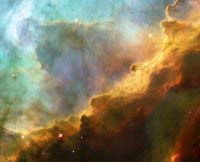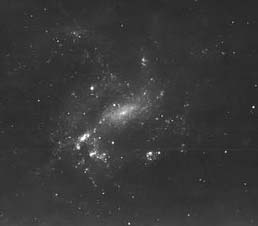This area deals with the fundamental laws and building blocks of nature and how they interact, the properties and the behavior of matter, and research into space and time and their structures.
innovations-report provides in-depth reports and articles on subjects such as astrophysics, laser technologies, nuclear, quantum, particle and solid-state physics, nanotechnologies, planetary research and findings (Mars, Venus) and developments related to the Hubble Telescope.

Like the fury of a raging sea, this anniversary image from the NASA/ESA Hubble Space Telescope shows a bubbly ocean of glowing hydrogen, oxygen, and sulphur gas in the extremely massive and luminous molecular nebula Messier 17.
This Hubble photograph captures a small region within Messier 17 (M17), a hotbed of star formation. M17, also known as the Omega or Swan Nebula, is located about 5500 light-years away in the Sagittarius constellation. The release of this image commemorates the thirte

VLT Spectra Indicate Shortest-Known-Period Planet Orbiting OGLE-TR-3
More than 100 exoplanets in orbit around stars other than the Sun have been found so far. But while their orbital periods and distances from their central stars are well known, their true masses cannot be determined with certainty, only lower limits.
This fundamental limitation is inherent in the common observational method to discover exoplanets – the measurements of small and regular changes in the centra

Academy Professor Matti Krusius and Antti Finne, M.Sc. (Eng.), were invited to a recent science breakfast, hosted by the Academy of Finland, to talk about their ongoing work to produce a first-ever laboratory simulation of a black hole. A black hole is created as a result of the most extreme concentration of matter.
Scientists have been arguing about the possible existence of black holes for an entire century. Today the existence of black holes is supported by various astrophysical phenomena

A team of theoretical physicists working at CERN and the Technion Institute of Technology in Israel has developed a theory to account for the mysterious gamma ray bursts that come from the depths of the Universe. According to their ideas, gamma ray bursts are linked to supernovae, the cataclysmic explosions of massive stars at the end of their lives. When a new gamma ray burst (GRB 030329) was seen on March 29 2003, the CERN-Technion team immediately predicted that light from a supernova would first

Scientists have uncovered a supermassive black hole at the core of a svelte, spiral galaxy, a finding that questions a recently devised rule of thumb in which only galaxies with bulging cores have such black holes.
Dr. Alex Filippenko, professor of astronomy at the University of California, Berkeley, and Dr. Luis Ho, an astronomer at the Observatories of the Carnegie Institution of Washington, in Pasadena, discuss these results in the May 1 issue of The Astrophysical Journal Letters.

Flares of distant supernovae may reveal major changes in early evolution of universe
Astronomers´ “yardstick” for measuring vast distances across the cosmos grew longer today as scientists at The Johns Hopkins University announced they had identified and closely analyzed two distant new instances of a kind of exploding star known as a Type Ia supernova.
The new supernovae belong to a group of star types known as “standard candles” that astronomers prize for their usefulness i